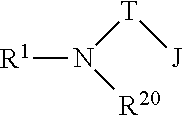Olefin oligomerization reaction processes exhibiting reduced fouling
a technology of oligomerization reaction and olefin, which is applied in the field of oligomerizing olefin, can solve the problems of increasing the complexity of transport, storage and handling, and the cost of purchasing these materials
- Summary
- Abstract
- Description
- Claims
- Application Information
AI Technical Summary
Benefits of technology
Problems solved by technology
Method used
Image
Examples
examples
[0163]Many catalyst systems have been developed to oligomerize ethylene into linear alpha olefins with higher commercial value. For example, a method for the efficient production of 1-hexene from the trimerization of ethylene has been described in U.S. Pat. No. 7,425,661. Under most relevant process conditions, the olefins produced may be in liquid phase or gas phase. These flowable products are relatively easy to process. However, many catalyst systems also produce a small amount of solid polymer byproduct, which can lead to significant problems. Polymer accumulation in the reactor inlet and outlet can reduce the ability to flow the products and can eventually render the reactor system totally inoperable. In a commercial setting, periodic shutdowns would be required to clean accumulated solids from the reactor and the attached tubing. a relatively high frequency of shutdowns would have a significant impact on the overall efficiency. A faster buildup of solid material would lead to ...
examples 1-5
[0165]For these Examples, the polymer anti-foulant used was high density polyethylene (HDPE) granules with an average particle diameter between about 500 microns and 1 mm. These granules are available commercially; however, for the purposes of this study, they were fabricated using the following method.
[0166]The granule fabrication procedure took place in a 1-liter autoclave reactor. The reactor was first treated with scavenger and half filled with isopentane. The reactor was then brought to at temperature of about 80° C. and pressurized with ethylene to about 160 psi (1.10 MPa). Catalyst was prepared by adding about 198.8 mg of supported (PrCp)2ZrCl2 on silica with approximately 3 ml of heptane to a catalyst injection tube. The catalyst was injected using ethylene at about 180 psi (1.24 MPa). The reaction was then allowed to proceed for about 45 minutes with the temperature controlled to about 80° C. At the conclusion of the reaction, the ethylene was vented off and the reactor was...
examples 6-11
[0175]In order to further refine this method, a second HDPE granule batch was made using the same procedure described previously. However, in an effort to increase the granule size, the catalyst amount was lowered to about 99.4 mg and the length of the reaction was increased to about 57 minutes. All other aspects of the HDPE granule fabrication procedure were maintained similar to that used in Examples 4-5. The granules made in this batch were later characterized and found to have an average particle diameter of about 813 microns. These HDPE granules will be referred to as HDPE “B”.
[0176]Six additional experiments were conducted using HDPE “B” using the same ethylene oligomerization procedure described previously. Examples 9-11 used about 5 grams of HDPE “B,” while Examples 6-8 used about 10 grams of HDPE “B”. The results are shown below in Table 2 below. As with the first set of experiments, all HDPE granules were assumed to all come out during filtration with the slurry polymer. T...
PUM
| Property | Measurement | Unit |
|---|---|---|
| mol % | aaaaa | aaaaa |
| pressure | aaaaa | aaaaa |
| pressure | aaaaa | aaaaa |
Abstract
Description
Claims
Application Information
 Login to View More
Login to View More - R&D
- Intellectual Property
- Life Sciences
- Materials
- Tech Scout
- Unparalleled Data Quality
- Higher Quality Content
- 60% Fewer Hallucinations
Browse by: Latest US Patents, China's latest patents, Technical Efficacy Thesaurus, Application Domain, Technology Topic, Popular Technical Reports.
© 2025 PatSnap. All rights reserved.Legal|Privacy policy|Modern Slavery Act Transparency Statement|Sitemap|About US| Contact US: help@patsnap.com



